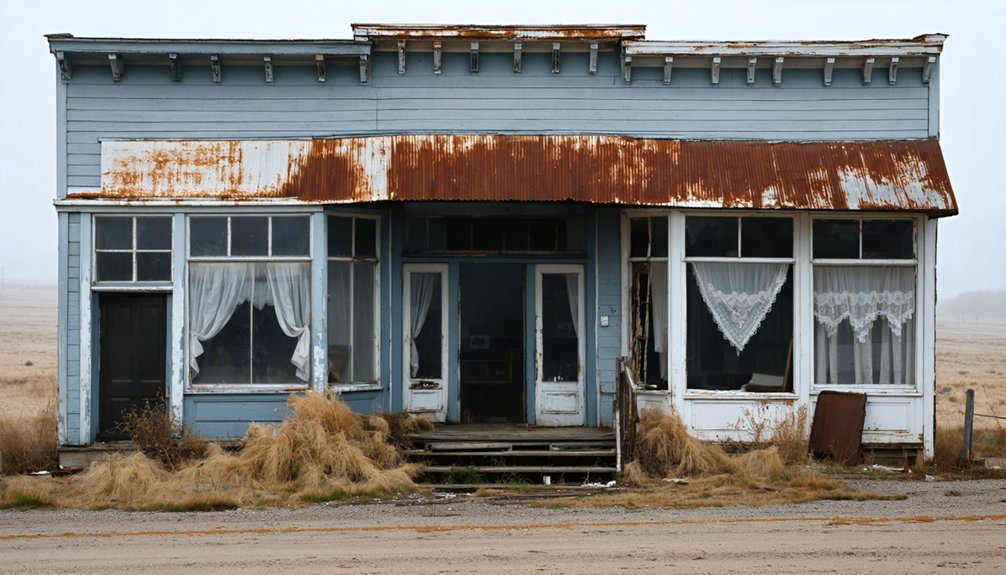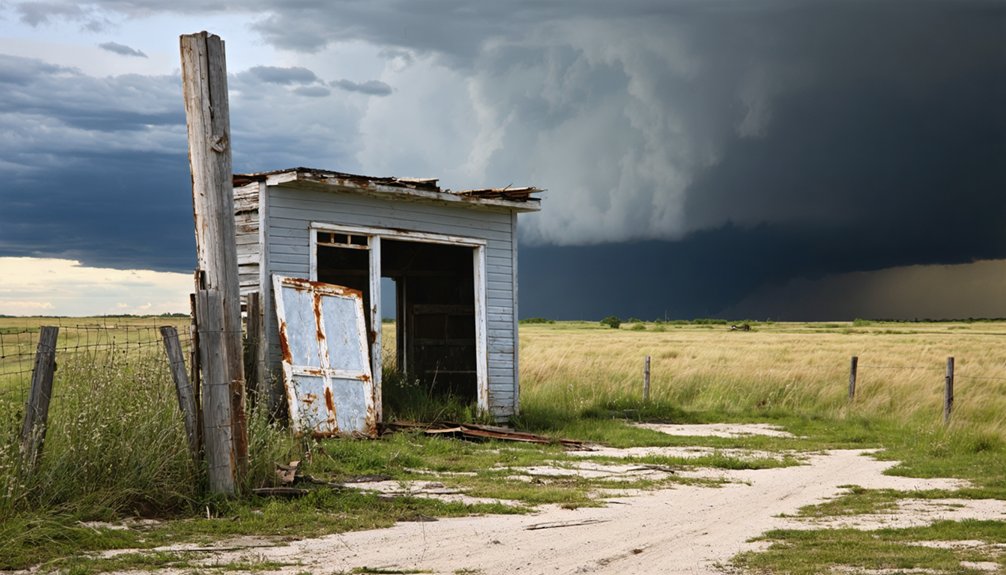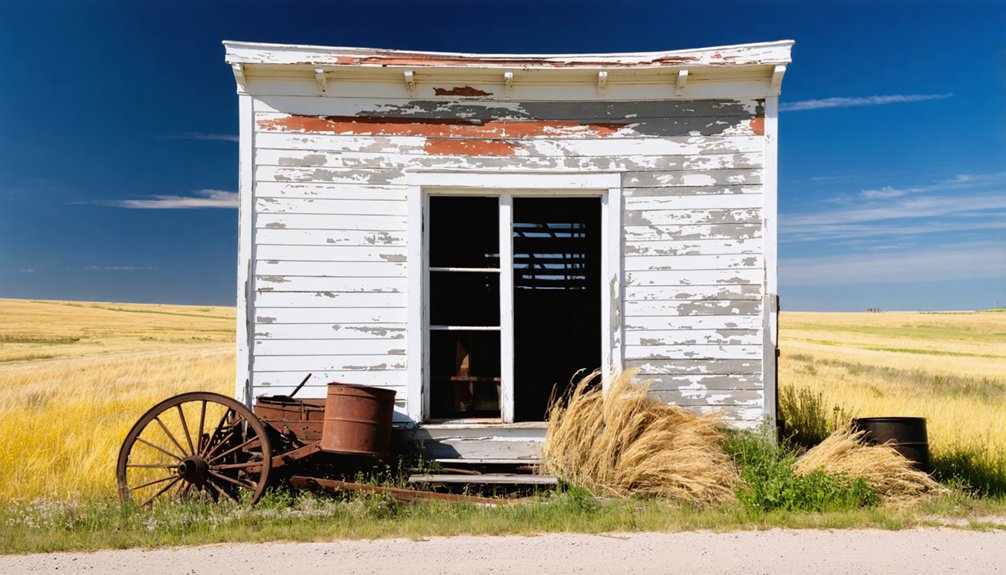You’ll find Sacora nestled in South Dakota’s Black Hills, where it sprang up during the 1874 gold rush that violated the Fort Laramie Treaty. The town flourished briefly with advanced mining operations, the prominent Calloway Hotel, and Milwaukee Road rail connections. By the early 1900s, dwindling gold production transformed Sacora into a ghost town. Today, weathered structures and scattered artifacts tell a complex story of frontier ambition, cultural displacement, and boom-to-bust economics.
Key Takeaways
- Sacora emerged during the 1874 Black Hills gold rush after Custer’s expedition, growing into a mining community before declining in the early 1900s.
- The town transformed from prosperous mining operations to a ghost town when local mines closed and miners departed the area.
- The Calloway Hotel served as Sacora’s social hub during peak mining years, gaining fame as the place where Calamity Jane died in 1903.
- Milwaukee Road railroad connections established in the 1880s briefly made Sacora a transportation center for regional grain shipping.
- Today, Sacora stands as a deteriorating ghost town with weathered structures and artifacts telling stories of frontier life and cultural displacement.
The Rise of a Black Hills Mining Settlement
When Lt. Colonel George Armstrong Custer’s 1874 expedition discovered gold in the Black Hills, you’d have witnessed a dramatic transformation of the region that would birth settlements like Sacora.
Despite the sacred Sioux treaty lands, thousands of prospectors flooded the area, facing mining challenges from the tough terrain and low-grade ore deposits. The rush of miners violated the Fort Laramie Treaty and sparked increasing tensions with Native American tribes. The Sioux chiefs Red Cloud and Spotted Tail traveled to Washington D.C. in 1875 to protest the invasion of their lands.
You’d have seen the community dynamics shift as diverse workers, including Chinese and black laborers, arrived seeking opportunities amid the economic downturn of 1873.
As mining operations evolved from simple placer methods to sophisticated hard rock extraction, Sacora emerged alongside other boom towns.
The introduction of advanced milling technology and chlorination processes helped overcome the area’s initially modest ore yields, establishing a foothold for this frontier settlement in the competitive Black Hills mining landscape.
Life in Early Sacora
Despite the harsh realities of frontier life, early Sacora emerged as a tight-knit community where survival depended on mutual support and resourcefulness.
In the face of frontier hardships, Sacora’s pioneers forged bonds of mutual aid that transformed strangers into family.
You’d find families sharing labor, supplies, and social bonds in this remote Black Hills settlement, where primitive housing and muddy roads marked the challenging landscape. Community gatherings, often held in churches or multipurpose buildings, strengthened the bonds between residents who faced common hardships together. The fur trade posts that once dominated the region had given way to more permanent settlements.
Early education took place in homes or shared spaces, with parents teaching their children basic skills. Beyond mining, you’d see settlers engaging in trades like blacksmithing or running general stores, while others hunted game or gathered timber to supplement their income. Like the early Dakota settlers who arrived before them in the 1860s, the residents struggled to build a life on the frontier.
When cash ran short, residents relied on bartering to exchange goods and services.
Mining Operations and Economic Growth
As the Black Hills gold rush of the 1870s spread from French Creek to Whitewood Creek, Sacora’s mining operations emerged from simple placer mining into more complex hardrock extraction.
You’d have seen mining technology evolve rapidly, with early hand-operated machinery giving way to sophisticated chlorination plants by the late 1880s. The discovery of gold at French Creek by Custer’s expedition in 1874 had set off the initial wave of prospecting that would eventually reach Sacora. Early miners relied heavily on pick and shovel methods before advancing to scientific approaches.
The town’s economic fluctuations mirrored its mining fortunes. While nearby Homestake Mine’s success brought stability to Lead, Sacora’s smaller operations struggled with low-grade ore and rising costs.
You would’ve found a bustling community of miners, merchants, and laborers during the boom years, with supply stores and hotels cropping up to serve the growing population.
But by the early 1900s, many local mines had shuttered, triggering a mass exodus that would ultimately lead to Sacora’s ghost town status.
The Calloway Hotel Era
If you’d visited Terry during the early 1900s, you’d have found the Calloway Hotel serving as a vital waypoint for miners, prospectors, and pioneers moving through the Black Hills region.
The hotel reached its operational peak between 1901-1903, when increased mining activity brought steady business and notable guests, including Calamity Jane during her final days.
Like the Delaware Hotel in Leadville, the Calloway featured modern steam heat and other amenities that made it a preferred lodging choice for travelers. Terry was once a bustling town with nearly 1,000 residents at its height.
Historic Lodging Operations
While gold mining drove the economy of Terry, South Dakota in the early 1900s, the Calloway Hotel served as the settlement’s primary lodging establishment and social hub.
You’d find basic hotel amenities common to the era, including steam heat, gas lighting, and both hot and cold running water. The multi-story building welcomed transient workers, miners, and travelers, offering furnished rooms that often doubled as makeshift offices or meeting spaces. With Terry’s population around 1,000 in 1893, the hotel played a vital role in accommodating the bustling community.
The historic hotel gained notoriety as the place where Calamity Jane died in 1903. At street level, you could access retail storefronts integrated into the hotel’s practical design. The establishment provided essential boarding services that helped sustain Terry’s fluctuating mining population.
Unlike grander hotels of the region, the Calloway maintained a modest but functional character, perfectly suited to the practical needs of a Black Hills mining community.
Peak Business Years
During the hotel’s peak years from 1902 to 1917, the Calloway Hotel emerged as Sacora’s commercial cornerstone, drawing a diverse mix of miners, merchants, and travelers to its prominent location on Main Street.
You’d find the hotel’s sturdy architecture and modern amenities setting new standards for the region, with its steam heat and running water attracting discerning guests.
The Calloway’s influence extended beyond lodging – it became a hub for local commerce and community engagement, hosting everything from business meetings to social gatherings.
Its well-furnished rooms and retail spaces helped sustain neighboring businesses, while its architectural significance made it a town landmark.
The hotel’s presence greatly boosted Sacora’s regional importance, improving infrastructure and establishing the town as an essential commercial center.
Eventual Hotel Decline
The Calloway Hotel‘s prosperous era came to an end as Terry’s mining industry faltered in the early 1900s.
You’d have witnessed the hotel operations dwindling as gold production decreased and miners left the area, leaving fewer guests to fill the rooms. The local economy couldn’t sustain the establishment that had once served as an essential waypoint for Black Hills travelers.
The hotel’s final claim to fame came in 1903 when Calamity Jane died within its walls, marking a symbolic end to the frontier era it represented.
Harsh winters and geographic isolation made it increasingly difficult to maintain profitable operations. The building, which had provided basic accommodations for miners and travelers, gradually succumbed to neglect as Terry transformed into another Black Hills ghost town.
Railroad Connections and Trade Routes
You’ll find the rail connections to Sacora followed the typical Dakota Territory pattern of strategic town platting, with the Milwaukee Road establishing a stop there in the early 1880s as part of its southeastern expansion.
The town’s position along the rail line made it a small but essential transportation hub for local farmers, who could now ship their grain directly to major markets in Minneapolis and Chicago.
While the rail station initially spurred Sacora’s growth and connected it to the wider regional economy, the town’s fate would ultimately mirror that of many other railroad-dependent communities in South Dakota.
Historic Rail Lines
As railroad expansion swept across southeastern South Dakota in the 1880s, Sacora’s development became intrinsically linked to the Chicago, Milwaukee, St. Paul and Pacific Railroad, commonly known as the Milwaukee Road.
You’ll find that this major rail line profoundly shaped the region’s settlement patterns, connecting Sacora to essential trading hubs like Sioux City and Mitchell.
The Dakota Southern Railway‘s presence further strengthened Sacora’s position in the regional trade dynamics, providing crucial links to the Platte line and broader South Dakota rail networks.
During this period, you could witness the strategic placement of towns every 5-10 miles along the tracks, transforming the landscape into a web of agricultural collection points.
These rail connections proved critical for local farmers, who relied on the railways to transport their grain to major processing centers in Minneapolis and Chicago.
Transportation Hub Impacts
Sacora’s prominence as a transportation hub stemmed directly from its strategic rail connections, which transformed the town into a significant nexus for regional trade.
You’d have found grain elevators and warehouses lining the rail sidings, where local farmers brought their harvests for shipment to major markets in Minneapolis and Chicago. The railroad significance extended beyond mere transport – it was your lifeline for essential supplies like fuel, food, and building materials year-round.
As a rail-connected town, Sacora enjoyed the economic advantages of being a central node in regional trade networks.
The trade impact rippled through the local economy, with businesses and markets flourishing around the depot. You couldn’t have missed the steady stream of agricultural products flowing through town, marking Sacora’s essential role in South Dakota’s rural commerce.
Daily Life and Social Fabric

Life in Sacora revolved around the demanding rhythms of mining work, with social activities centered primarily in the town’s saloons and informal gathering spots.
You’d find a mix of stable families and transient workers sharing the rugged frontier experience, their daily routines shaped by the harsh realities of mining life. Community gatherings often took place at the local church, which served as both a spiritual center and social hub for residents seeking respite from their labor-intensive days.
Miners and their families found solace in the local church, a sanctuary from the grueling work that defined frontier life.
In your wooden cabin or modest home, you’d face the challenges of brutal winters and isolation, relying on the town’s merchants and service providers for essential supplies.
The social fabric wove together miners, their families, and various tradespeople, creating a resilient community that adapted to the boom-and-bust cycles of mining economics.
The Decline Years
The harsh realities of mining economics struck Sacora in the late 19th century, marking the beginning of its steady descent into abandonment.
As gold yields diminished, you’d have seen the telltale signs of economic hardship spreading through the community – shuttered storefronts, declining population, and crumbling infrastructure.
The lack of railroad connections sealed Sacora’s fate, while the Great Depression delivered the final blow to this once-bustling mining town.
You’ll find evidence of this decline in the abandoned infrastructure that still dots the landscape – deteriorating mine shafts, empty ore bins, and rusted cyanide vats.
Natural forces took their toll too, as harsh Black Hills weather and tornados accelerated the decay of unmaintained buildings.
Present-Day Site Conditions

Standing amid the western South Dakota prairie, weathered remnants of Sacora’s past dot the landscape where you’ll find deteriorating wooden structures, crumbling foundations, and isolated walls that hint at the town’s former significance.
You can easily access the site via dirt roads from nearby campgrounds, making it perfect for a family exploration. Nature’s reclamation is evident as prairie grasses and shrubs overtake the buildings, while local wildlife now inhabits these abandoned spaces.
Though there’s no active preservation, the site’s authentic ruins tell their own story through scattered artifacts, mining equipment, and architectural features.
You’ll discover a peaceful, self-guided experience among the ghostly remains, though you won’t find modern facilities – just the raw beauty of history slowly fading into the western landscape.
Legacy in Black Hills History
Nestled within the complex tapestry of Black Hills history, Sacora emerged during a transformative period when the region’s identity shifted from Native American sacred ground to mining frontier.
Like many Black Hills settlements, Sacora’s story reflects the broader narrative of Treaty violations and cultural displacement that followed the 1874 gold discovery.
The dark legacy of the Black Hills gold rush lives on through ghost towns like Sacora, monuments to broken promises and displaced peoples.
- You’ll find echoes of the region’s transformation from Lakota sacred territory to mining boomtown.
- The town’s rise coincided with the forced relocation of Native American tribes from their ancestral lands.
- Sacora represents one of many sites that emerged after the U.S. government broke the Fort Laramie Treaty.
- The town’s remains serve as a reflection of the cultural significance of the Black Hills’ contested history.
- Historical preservation efforts help tell the complex story of conflict, settlement, and change.
Frequently Asked Questions
Were Any Notable Outlaws or Gunfighters Known to Visit Sacora?
You won’t find documented outlaw sightings or gunfighter legends in Sacora’s historical record. Unlike nearby Deadwood, this small Black Hills settlement never attracted notable Wild West figures based on available evidence.
What Happened to the Original Mining Equipment and Machinery After Abandonment?
Like ghosts of industry past, you’ll find most abandoned machinery rusted in place – too massive to move. Some mining relics were salvaged, but most heavy equipment stayed where operations ceased.
Did Any Native American Tribes Have Settlements Near Sacora?
You’ll find the Lakota Sioux maintained Native settlements near Sacora by the 1700s, with significant tribal influence from both Oglala bands and Dakota groups who controlled this western South Dakota territory.
Are There Any Documented Paranormal Activities or Ghost Stories From Sacora?
Like whispers in empty streets, you won’t find documented ghost sightings or haunted locations in Sacora. Unlike other Black Hills ghost towns, there aren’t any verified paranormal activities in historical records.
What Natural Disasters or Extreme Weather Events Affected Sacora’s History?
You’ll find no specific disaster records, but the area endured harsh winters, persistent droughts impacting crops, and strong winds. Regional flood damage and drought impact gradually wore down the community’s resilience.
References
- https://www.youtube.com/watch?v=Glucs_Rq8Xs
- https://www.sdhspress.com/journal/south-dakota-history-2-2/some-black-hills-ghost-towns-and-their-origins/vol-02-no-2-some-black-hills-ghost-towns-and-their-origins.pdf
- https://www.sdpb.org/rural-life-and-history/2023-08-21/some-black-hills-ghost-towns-and-their-origins
- https://www.powderhouselodge.com/black-hills-attractions/fun-attractions/ghost-towns-of-western-south-dakota/
- https://icatchshadows.com/okaton-and-cottonwood-a-photographic-visit-to-two-south-dakota-ghost-towns/
- https://www.youtube.com/watch?v=_0WNYsFLSLA
- https://en.wikipedia.org/wiki/List_of_ghost_towns_in_South_Dakota
- https://www.blackhillsbadlands.com/blog/post/old-west-legends-mines-ghost-towns-route-reimagined/
- https://www.onlyinyourstate.com/experiences/south-dakota/capa-ghost-town-sd
- https://www.ebsco.com/research-starters/history/black-hills-gold-rush



